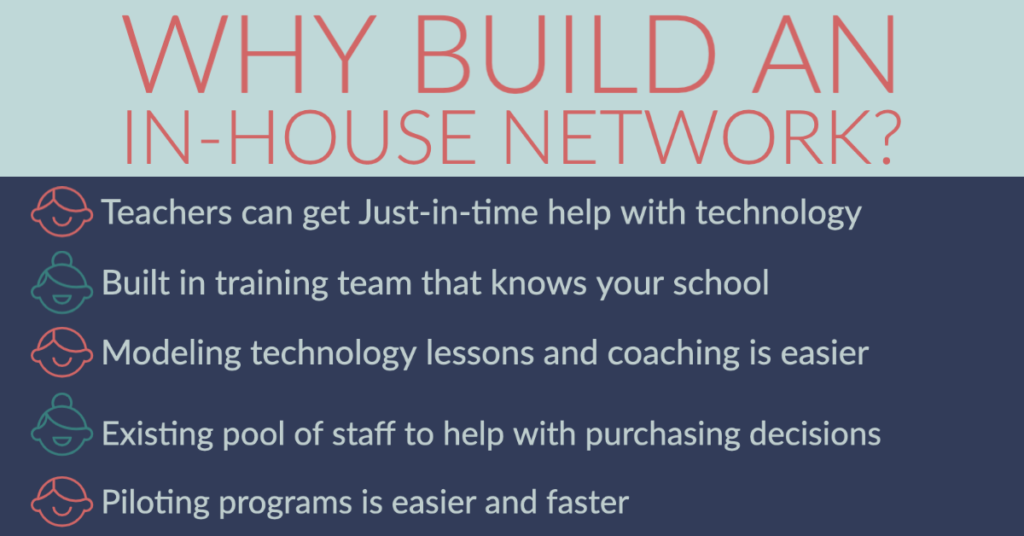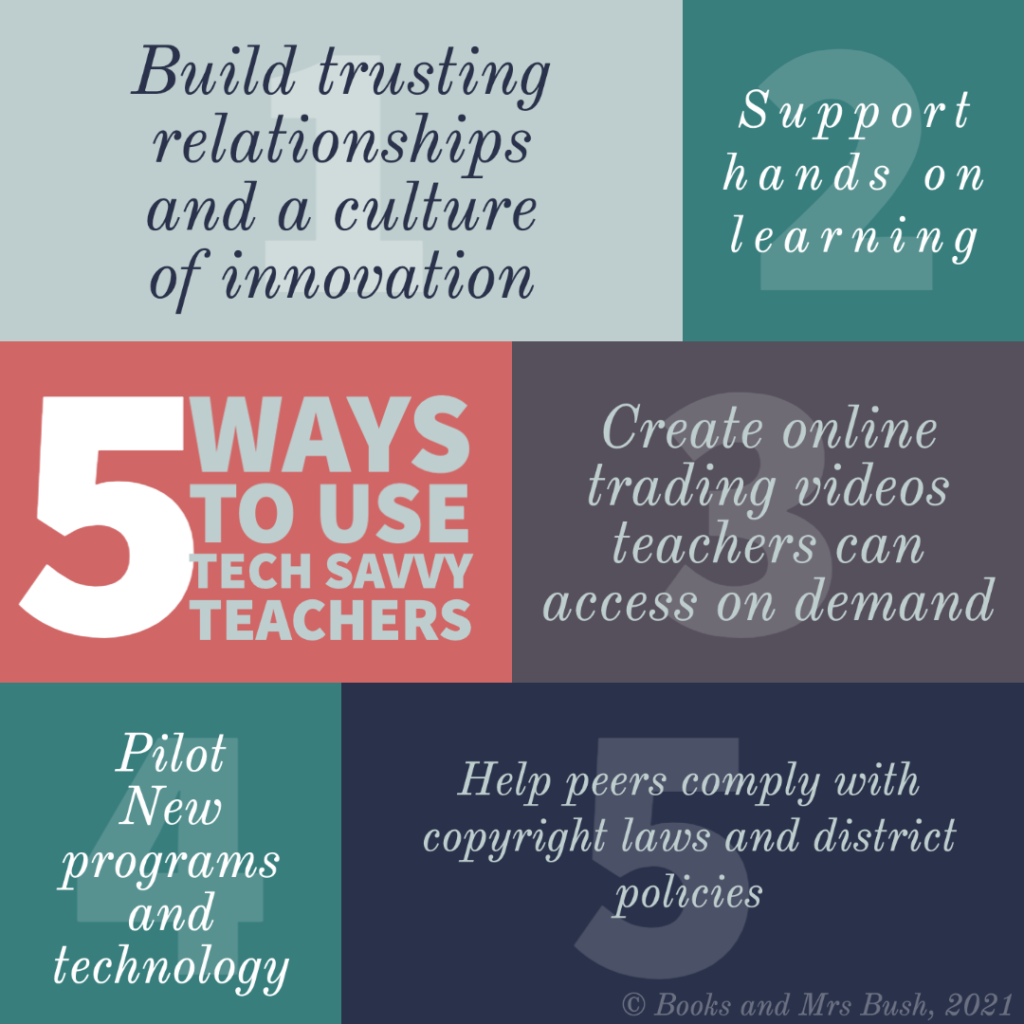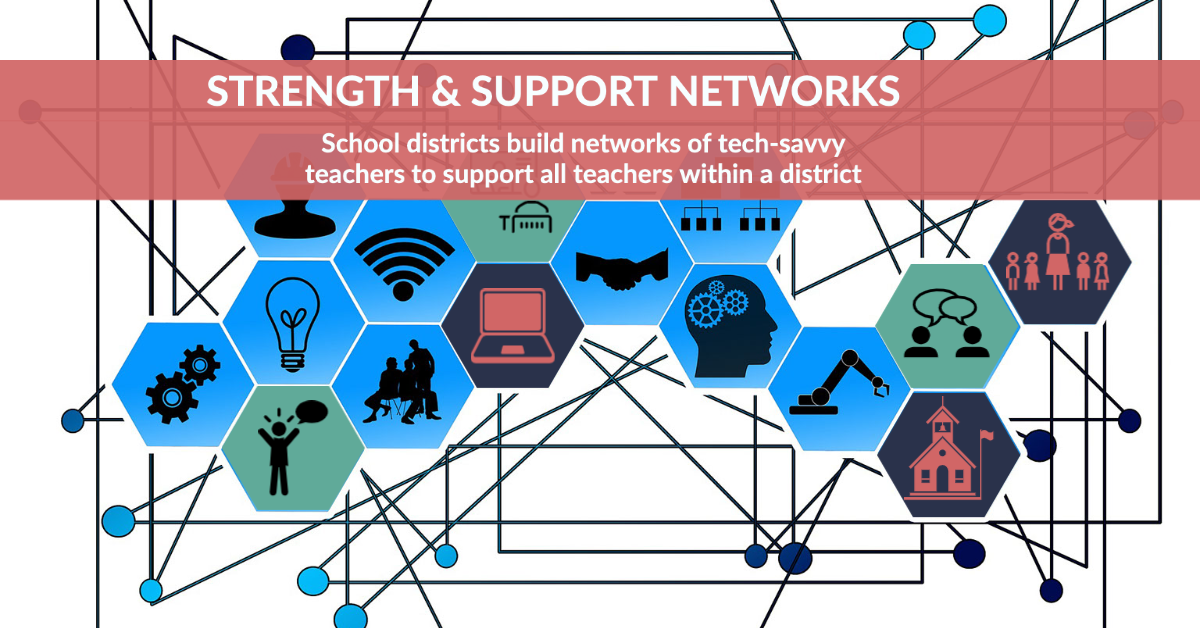Most educators agree that technology is important in the classroom, but many educators struggle with its use. In fact “a 2013 national survey of more than 900 K-12 teachers and administrators, conducted by Common Sense Media, found that while 96% of respondents believe technology has a positive effect on student engagement, 43% of teachers surveyed believe that a lack of training for teachers on how to use and implement technology is one of the biggest challenges to integrating edtech in schools” (Commonsense Media, 2014). For this reason, it’s important that schools develop ways to build additional supports for staff beyond district-level IT and instructional specialists. One way to do so is to connect tech-savvy staff with staff who struggle with technology through a strong in-house network that can serve as a resource.
4 Reasons to Build an In-House Network of Tech-Savvy Teachers
1. Teachers know the end users best.
Teachers are key stakeholders in the integration of technology. Every class has its own specific population, classroom culture, and classroom management; and classroom teachers know all of these elements with an intimacy that can only be gained through daily contact. Teachers can be the best choice for making technology decisions because they know first hand what will and won’t be used, and “since there’s an ever-growing pool of digital resources out there, finding the right tools for the right classroom is easier said than done” (Andrade, 2020), teachers can help find the most useful tools.
2. There are gaps in the knowledge network.
Even with PD and access to technology and district level IT experts, the sheer number of teachers in a district means that many can get lost in the system. A 2018 survey found that 25% of teachers didn’t understand their existing learning tools, and another found that “only 10 percent of 2,000 K–12 teachers surveyed are confident in incorporating higher-level technology” (Andrade, 2020).
3. Teachers are Consistent.
Often Instructional Specialists and IT staff/items are the first to be cut when school districts face budget shortfalls. However, teaching staff is less likely to be cut, and building a strong network of teacher-experts can keep educators from falling through gaps left as district staffing changes:”though ed tech departments may come and go, having skilled colleagues available to support teachers along the way remains important” (Bentley, 2019). If all expertise is centralized in district staff of building Instructional Coaches, teachers are left rudderless when those positions are cut. Expanding the concept of PD for instructional technology to include a network of tech savvy teachers can prevent losses in understanding when that happens.
4. Teachers can Provide each other Ongoing Support.
One of the most common gaps in technology PD is the lack of ongoing support, “It’s unrealistic to expect teachers to become experts on new technologies overnight, so training should be ongoing and progressive — and capture their interest” (Andrade, 2020). Further, “teachers learn best through ongoing, job-embedded training,” and “one of the least expensive ways to make that happen is to have teachers teach each other” (Commonsense Media, 2014).

5 Useful Tasks Tech-Savvy Teacher Teams Can Do
There are many ways in which tech-savvy teachers can support their colleagues. The list below is just a portion of the many ways in which they can do so. However, as you consider these options, please also consider using stipends, additional planning time, or other measures to ensure that these teachers are able to support their peers without being overworked themselves.
1. Provide Recorded Online As-Needed Training
One thing we have learned during emergency remote teaching is that teachers can adapt curriculum and learn to use technology tools when they have access to digital learning opportunities that they can use at their own pace asynchronously. For districts, this can include a series of digital video trainings or interactive technology-based training. Bentley observes that “developing and posting online training videos for teachers to use as-needed has proven successful in many districts, and for a wide range of applications” (Bentley, 2019). When the individuals creating these videos are part of the same schools and districts as the teachers watching them, the videos can be targeted to their unique needs.
Additionally, having in-building experts can build opportunities for teachers to reach out to others for support and reminders regarding how the technology works as they access the technology tools. Micah Brown, who fills this role in the Andover School District in Kansas explains that it is important to “have a person behind the learning [who can] provide that ongoing support, even if it’s not in a formal capacity,” (Klein, 2021). When the expert who provides help is in the classroom next door, a teacher is much more likely to access them.
2. Support Natural Hands On Learning.
Several surveys identify the need for ongoing training or hands on time with technology for teachers to develop strong skills. Incorporating a network of tech-savvy teachers into the school’s ongoing training time allows teachers an opportunity to work with technology with the support of someone they know and trust, or visit other classrooms to see the technology in use. In this way, “teachers can learn how to use these tools just as their students do — through trial and error and watching how others do it” (Andrade, 2020).
3. Help Teachers Comply with Laws and Mandates.
One of the challenges of incorporating new ideas in classrooms is ensuring that teachers do so in alignment with copyright laws and district use policies. Not doing so can put students’ data and safety at risk. Teachers can support one another by “talking about digital citizenship and complying with data privacy laws, when incorporating it in their lesson plans” (Andrade, 2020). This has the dual positive effect of supporting teachers in compliance and reinforcing that compliance is a cultural norm within the school.
4. Pilot New Programs and Technology
Often tech-savvy teachers are early adopters of technology. Using this network of individuals to pilot new technology can serve a dual purpose: it can “observe and measure the impact of new technology in the classroom while evaluating [how] the use of those technologies aligns with your district’s goals and assess what it would take to continue supporting them” (Andrade, 2020).
5. Build Safe-Trusting Relationships
A network of technology savvy teachers that are also trained in best practices for academic coaching can help a school or district develop a culture of innovation and trust regarding technology. Pairing these individuals with colleagues who may be hesitant to adopt new technology and helping them develop a coaching relationship can result in greater use of and trust in technology as a teaching tool.

6 Ways to Build a Network of Tech Savvy Teachers
1. Use common language, and involve everyone.
An essential part of building an effective program is ensuring that all stakeholders are using the same language and onboard with the long term goals. Andrade emphasizes the importance of this and suggest that districts create opportunities as part of the initiative to encourage buy in, including “new career paths or improving accessibility in the classroom. . . let that guide the kind of tools and training you need to apply” (Andrade, 2020). This inclusivity creates a structure that supports the creation of a network of teachers who support their peers.
Schools in Palm Beach County, Florida provide an example of a successful implementation of common language. At this district, teacher technology leaders engage in professional development that teaches them to “adopt common language and standards-based instructional practices using tools. . .and share their expertise with colleagues and other schools to improve teaching and learning districtwide” (Blackburn, 2020). Because these teachers are trained using the same language, they’re able to maintain consistency across multiple grade levels and buildings.
2. Include Recognition and Fun
Teachers are people first, and are often driven by the social and engaging aspects of teaching as much as by the paycheck. Injecting fun and recognition is a way for districts to tap into this drive. One example of a successful program that does so is the digital badge program from Katy School District in Texas. Blackburn explains the program, saying “to earn a badge, teachers must first complete an up to 45-minute asynchronous course. Next, they must show evidence of the tool being used in the classroom and provide a short reflective summary of how it improved learning” (2020). The district maintains a virtual teacher leaderboard showing teachers’ badges, and provides real life badges teachers can display on their classroom doors. This serves both as a point of pride and as an indicator that the teacher is an excellent resource in the topic for which they’ve earned a badge.
3. Incorporate Choice.
Traditionally, teacher training has been top-down, with leaders choosing the topics and trainers, and teachers attending “sit and get” training during their training days. But, when you empower a groups of teachers to become technology leaders this results in a fundamental shift in ownership of training from administration to teachers. Encouraging, rather than fighting, this shift can support the success of your team of teachers.
One example of this is Quakertown school district, in which teachers choose from 70 hands on sessions during professional development, many of which are led by their fellow teachers (Commonsense media, 2014). Adding the element of choice and the empowerment of in-building teachers to lead sessions has shifted the district’s culture to one of growth and teacher ownership of technology learning.
4. Encourage Collaboration
Farmington Public Schools in Connecticut uses in-house experts differently, having instituted an innovative system pulled from the methods used by hospitals to train doctors. In the same way that hospitals use “rounds” to ensure that all of the staff involved are updated on each patient’s status and plan of care, Farmington Public School teachers engage in instructional rounds. These teachers gather together to “observe students in action and determine the next steps to improve their learning” (Commonsense Media, 2014). This is one example of encouraging collaboration and discussion among teachers to support student learning. By building a culture in which collaboration is a norm, and supporting that collaboration through programs such as this, schools can encourage teachers to work together on technology challenges.
5. Step outside your comfort zone.
Innovation should not be limited to technology, and thinking outside the box can result in benefits for both technology and teaching teams. This includes rethinking the structure and goals of teacher training.
One example of a change in structure occurs at West Pender Middle School, where an instructional technology leader and language arts teacher worked together to create “an elective course that aligns with CCSS eighth grade language arts standards” which promoted both instructional rigor and technology use (Commonsense Media, 2014). This in turn resulted in technology training for teachers in the district modeled on the way in which students in the gaming class learned through workshops in which they played games with the guidance of experts from their building, “and look for vocabulary that is challenging to students, and. . .discuss digital citizenship and online safety in preparation for conversations with students.” (Commonsense media, 2014).
Moving beyond district traditions in training teachers and developing a network of tech-savvy teachers involves a creative, intentional use of time. For example, “one school increased class sizes slightly so every teacher could have two planning periods a day,” and others “have staff members, including coaches, guidance counselors, and media specialists, give lessons that allow teachers time for collaboration” or set aside time for “one grade level each week to have the entire day for planning—which meant other grade levels had to forfeit their planning periods that day” (Davis, 2021). These methods require buy in at all levels and coordination of planning time.
6. Allocate Resources for Tech-Savvy Teacher Teams
Ultimately, the long term success of effective programs requires schools to allocate resources to support them. The Palm Beach County school district mentioned previously created their “Teaching with Technology Trailblazers” program, and provided paid training that resulted in nearly all of the districts 2,400 Trialblazers to become Google Certified Educators (Blackburn, 2020). The Quakerton School District allocated time to reconfigure their data tracking regarding the success of professional development away from teacher work hours and instead “tied professional development to continuing improvements in their and students’ performance” (Commonsense Media, 2014). These are two examples of ways districts committed to building programs in which teachers can form learning networks for technology use reallocated funds and time towards their success.
Conclusion
While school districts sometimes struggle with funding effective and cost-efficient professional development, they can see in-house experts as an option to replace more expensive programs. Additionally, sometimes teacher experts can serve as replacements for district level instructional technology experts. However, teacher experts can serve best working alongside outside experts and district staff to create a network of technology expertise that helps support all teachers throughout the year. They should not be an either-or, but an additive option used in addition to district level technology staff and expert PD providers to increase the efficacy of technology professional development and use.
Resources & Understand
Andrade, D. (2020, August 5). 4 Ways to Develop a Team of Forward-Looking Tech Enthusiasts. Technology Solutions That Drive Education. https://edtechmagazine.com/k12/article/2020/02/4-ways-develop-team-forward-looking-tech-enthusiasts
Bentley, K. (2021, April 20). Do School Districts Still Need Ed Tech Support Staff? GovTech. https://www.govtech.com/education/k-12/do-school-districts-still-need-ed-tech-support-staff.html
Blackburn, S. (2020, May 13). 4 districts that incorporate innovative ed tech in PD and in the classroom. District Administration. https://districtadministration.com/4-districts-education-technology-teacher-digital-skills-digital-badging-school-manufacturing-programs/
Common Sense Media. (2014). Innovative Professional Development Helps Teachers Use Technology to Tackle CCSS. Graphite. https://www.commonsense.org/education/sites/default/files/tlr-blog/graphite-whitepaper-professionaldevelopment-040214.pdf
Davis, M. R. (2021, September 13). School Districts Update Professional Development. Education Week. https://www.edweek.org/leadership/school-districts-update-professional-development/2017/04
Klein, A. (2021, May 19). How to Fix 7 Fatal Flaws in Tech Professional Development. Education Week. https://www.edweek.org/leadership/how-to-fix-7-fatal-flaws-in-tech-professional-development/2021/05

Teachers love the idea that help is just down the hall when it is needed. This is such a powerful set of ideas about how schools can utilize teachers to turn that idea into daily practice and provide ongoing and essential professional learning. What kind of professional learning do the teachers need to make this form of collaboration effective. And what kind of institutional support is needed from school and district leaders to turn this idea into practice? I hope you have the opportunity to try out some of the ideas you so clearly outlined here. And I hope you will write about your experiences to answer the questions I raised.
Thank you for these questions. I genuinely believe that teachers participating in any tech-savvy learning team would need professional development in communication and coaching (beginning with some of the overview information that Vivian provided in her post, and the active listening skills Mun outlined), and in the district and state laws/guidelines. In my experience innovation is important, but can become a problem when innovators don’t take into account copyright laws or digital safety rules (for example, those that protect student privacy).
I still need to reflect on the institutional support necessary to make this work. At the very least, buy-in from leadership and time/compensation for planning, training, and meetings is essential.
Hi Deanna, I agree wholeheartedly with you that lack of training is one of the biggest hindrances to edtech adoption in schools and that schools need to be more proactive in leading training rather than relying solely on district-level support. Thank you for presenting a compelling case advocating this. I like your suggestion on ways to build tech-savvy teacher teams to provide in-house support. This sounds like a very practical solution and with a bit of careful and considerate pairing, I believe this could potentially be a very effective method.